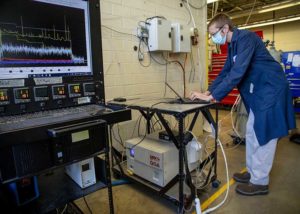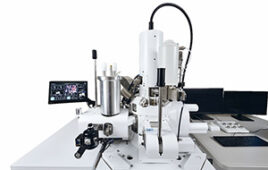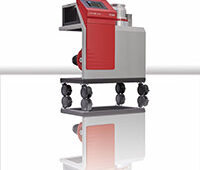
Southwest Research Institute researchers combined SwRI’s USGR system with a mass spectrometer for more precise evaluation of aftertreatment system emissions. The merger of the two technologies produces high-quality data in real time, allowing accurate and swift measurement of a broad range of pollutants and gases. Courtesy of Southwest Research Institute
Southwest Research Institute has expanded its capability to evaluate internal combustion engine aftertreatment catalysts, integrating an existing SwRI technology with a mass spectrometer. To meet emission regulations, engine manufacturers install aftertreatment systems to treat exhaust and reduce harmful pollutants escaping into the environment. Aftertreatment system components undergo stringent testing to ensure they effectively decrease pollutants. SwRI is bolstering the testing process by incorporating a mass spectrometer, enabling a broader range of aftertreament performance evaluations in real time.
A mass spectrometer identifies a molecule by analyzing its mass-to-charge ratio, detecting chemicals invisible to other instruments. Researchers added the mass spectrometer to SwRI’s Universal Synthetic Gas Reactor (USGR), a catalyst performance testing solution that incorporates a Fourier Transform Infrared (FTIR) spectrometer, which uses IR radiation to identify and quantify molecules present in a gas sample. Different chemical structures absorb light at specific wavelengths, producing unique spectral fingerprints. The combination of technologies provides simultaneous FTIR and mass spectrometry data, allowing accurate and rapid identification of exhaust stream components.
“We integrated a mass spectrometer with the USGR system to overcome the limitations of the FTIR spectrometer, which cannot monitor chemicals that are infrared inactive like dinitrogen, oxygen and hydrogen,” said Dr. Grant Seuser, a postdoctoral researcher in SwRI’s Powertrain Engineering Division who led the project. “The mass spectrometer can detect a broader range of exhaust components, allowing a more complete picture of aftertreatment system performance.”
The FTIR monitors pollutants, while the mass spectrometer detects hydrogen, oxygen and dinitrogen formation, providing data to build comprehensive scientific models of the catalyst. The merger of the technologies enables testing of three-way catalysts in real time.
“Real-time information is important,” Seuser said. “Emission regulations are based on the total amount of pollution emitted. When we are testing equipment that controls emissions, we not only need to know how much pollution is leaving the tail pipe, but also exactly when it is emitted. Real-time monitoring helps us identify problems faster.”
The successful integration of a mass spectrometer with the USGR system has widened the scope of testing possibilities beyond aftertreatment systems. Other uses include measuring engine emissions directly, monitoring chemical processes, environmental monitoring, battery testing and much more. SwRI offers the specialized evaluation and development services to a range of clients, including engine, vehicle and catalyst manufacturers.
For more information, visit Catalyst Analysis Services





Tell Us What You Think!